Pencil grasp development is a common concern for many parents, teachers, and therapists. So often, we see children holding a pencil with all of their fingers wrapped around the pencil, or very awkward pencil grips and wonder what is a typical pencil grasp. But, did you know that children typically progress through pencil grasp development in a predictable pattern? It’s true! Let’s talk pencil grasp.
First, when it comes to writing with a pencil, there are a few things that therapists want parents to know about pencil grasp.
Secondly, it’s important to note that grasp development, while it can be predictable, can also vary in timing. And when grasp doesn’t follow the progression listed below…it can be ok! In fact, a functional pencil grasp is perfectly fine for children.
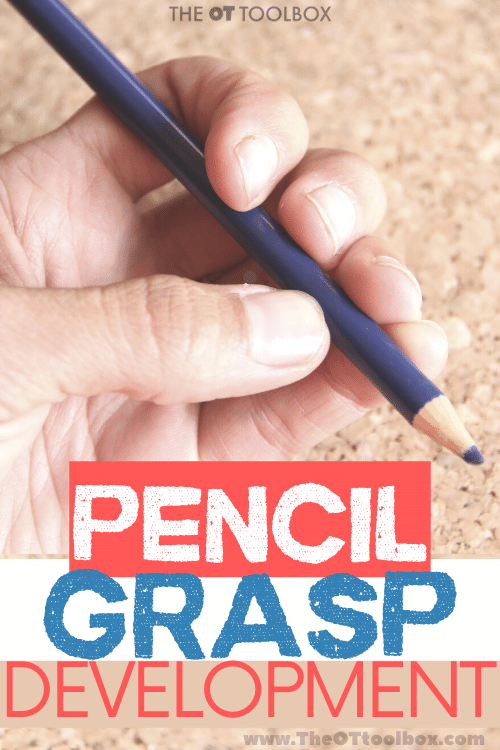
Pencil Grasp Development
Grasp development follows three main categories: primitive grasps, transitional grasps, and mature grasps.
Primitive Pencil Grasps
In this beginning pencil grasp, the whole arm moves the pencil. These grasps include two specific grips which are described below:
- Palmer Supinate Grasp (a whole hand grasp)
- Digital Pronate Grasp
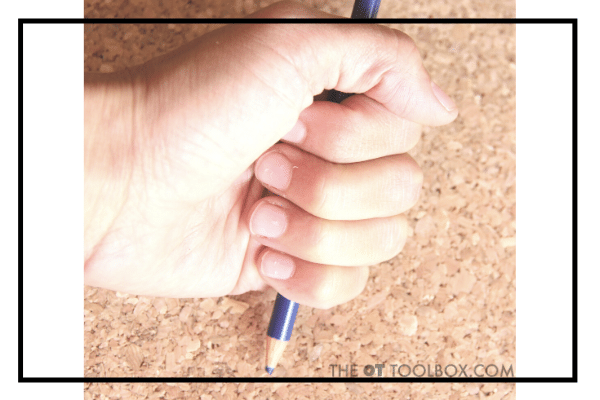
1. Whole Hand Grasp/Palmer Supinate Grasp- (Typically seen between 12 months-1.5 years) Child holds the crayon with their whole hand, with the writing end of the crayon sticking out near their pinkie side of the hand. It looks like they are holding a paint stirrer or potato masher.
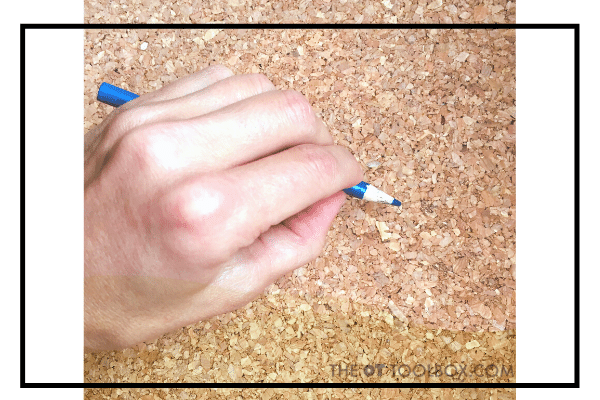
2. Digital Pronate Grasp/ Pronated Wrist Grasp- (2-3 years) Crayon is held in the hand so the tip of the crayon (or the drawing end) is held on the thumb side of the hand.
Transitional Pencil Grasps
In the transitional pencil grasp stage, the child’s forearm and/or wrist moves the pencil.
Transitional Pencil Grasps include:
- Quadrupod grasp
- Static Tripod grasp
- Other grasp patterns
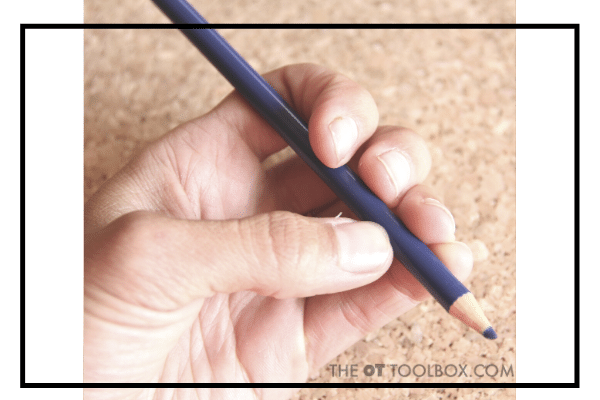
1. Quadrupod Grasp, or Four Fingered Grasp- (3-4 years)- Crayon is held between their thumb, and tips of the pointer finger, middle finger, and ring finger. As the child progresses, these four fingers may pull down to the tip of the finger into a quadrupod grasp.
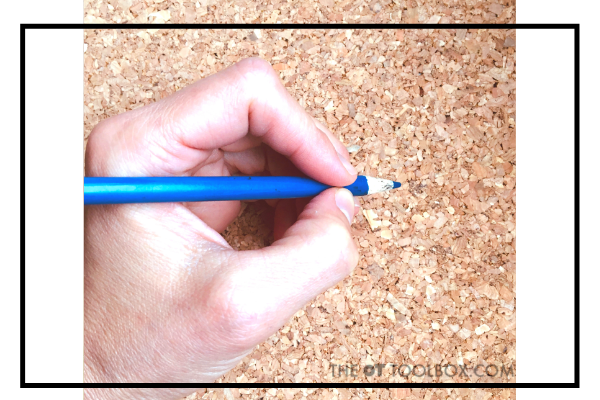
2. Static Tripod Grasp- (3.5-4 years)- Child holds the writing utensil with the thumb, pointer finger, and rests the utensil on the last joint of the middle finger. The ring finger and pinkie fingers are tucked into the palm of the hand.
3. Other grasp patterns- There can be many variations of grasp patterns that occur in the transitional stage, marked by the use of the wrist or forearm to move the pencil.
Mature Pencil Grasps
In the mature pencil grasp stage, the child holds and maneuvers the pencil using mobility in the fingers or the hand.
Mature grasp patterns include:
- Dynamic Tripod Grasp
- Lateral Tripod Grasp
- Dynamic Quadrupod Grasp
- Lateral Quadrupod Grasp
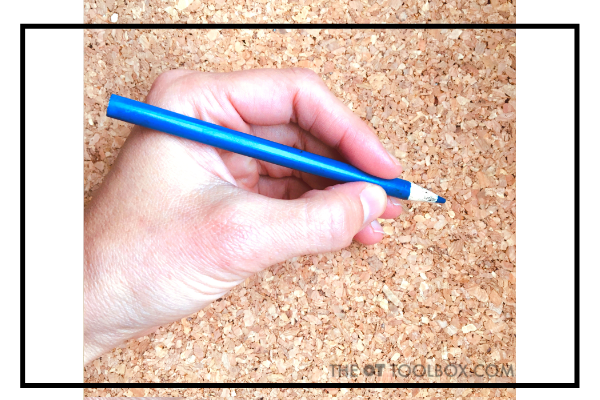
1. Dynamic Tripod Grasp- (4-6/7 years) Thumb and pointer finger hold the pencil as it rests on the last joint of the middle finger. Pencil movements occur via manipulation of the fingers and hand. Note that a true dynamic tripod grasp may not be established up until around 14 years of age.
2. Lateral Tripod Grasp- Thumb is pressed in against the pencil (or adducted) to hold the pencil against the side of the pointer finger. The tip of the thumb may bend over (or flex) over the pencil in a “wrapped” position. This grasp is sometimes called a thumb wrap grasp because the thumb is not involved with the distal movement of the pencil. Distal mobility occurs, but it is the index and middle fingers manipulating the pencil.
3. Dynamic Quadrupod Grasp- Grasp is similar to the dynamic tripod grasp, but opposition includes the thumb, pointer finger, middle finger on the pencil shaft.
4. Lateral Quadrupod Grasp- Grasp is similar to the lateral tripod grasp, with its thumb wrapped positioning of the thumb, but uses the pointer, middle, and ring fingers are on the pencil shaft and manipulate the pencil.
Quadrupod Grasp
One thing that is important to mention is the quadrupod grasp. You might have noticed this term was mentioned a few times above, and in difference areas of development through the progression of pencil grasp development.
The quadrupod grasp is considered a four finger grasp, in which four fingers (thumb, pointer finger, middle finger, ring finger) are used to hold the pencil. Quadrupod grasp progresses from a static form to a dynamic form where there is fluid motion and repositioning in the joints of the hands.
Quadrupod Grasp- If the thumb opposes the pointer finger, middle finger, and ring finger this may be called a quadrupod grasp. A quadrupod grasp can also occur with the pencil resting on the side of the ring finger.
The quadrupod stage is an important part of grasp development as the fingers move into a dynamic position with pronation and extension of the wrist. However, don’t get stuck on a quadropod grasp if this type of grip is used with older children or if students are established with their quadrupod grasp!
Quadrupod grasp or Tripod Grasp?
Research tells us that the quadrupod grasp is a very functional grip and the use of one extra finger (as opposed to the traditional sense of a tripod grasp) is actually very functional in written work.
Some may say that the quadrupod grasp is more restrictive than the tripod grasp, however that extra stability can actually promote more mobility in the pencil and be used in very efficient and effective handwriting.
When the child that the uses a quadrupod grp on the pencil is forced to use a tripod grasp, you may see a decrease in written work legibility due to decreased stability. The arches of the hands may need to compensate for strength and dexterity in the fingers and that precise placement that the ring finger adds to the shaft of the pencil just isn’t as targeted with the arches of the hand and the stability offered through the ulnar side of the hand. For those who have the stability in the ulnar side and within the arches or intrinsic muscles, a tripod grasp can be more precise and lead to more refined pencil motions.
So you can see that it all is up to each individual when it comes to forcing a student to move from quadrupod to tripod. It just may not make sense to do so for some…and that’s ok and very functional!
Other Functional Pencil Grasps
There are other grasps that can be considered “functional” in which the child holds the pencil differently than described here, but can also write in an efficient manner.
These can include (but not be limited to) a thumb wrap grasp, thumb tuck grasp, inter-digital brace grasp, or a finger-wrap grasp.
How to help with pencil Grasp
Want to know more about pencil grasp progression, development, and strategies to use to help children build a strong, efficient, and functional pencil grasp? It’s all in the Pencil Grasp Bundle!
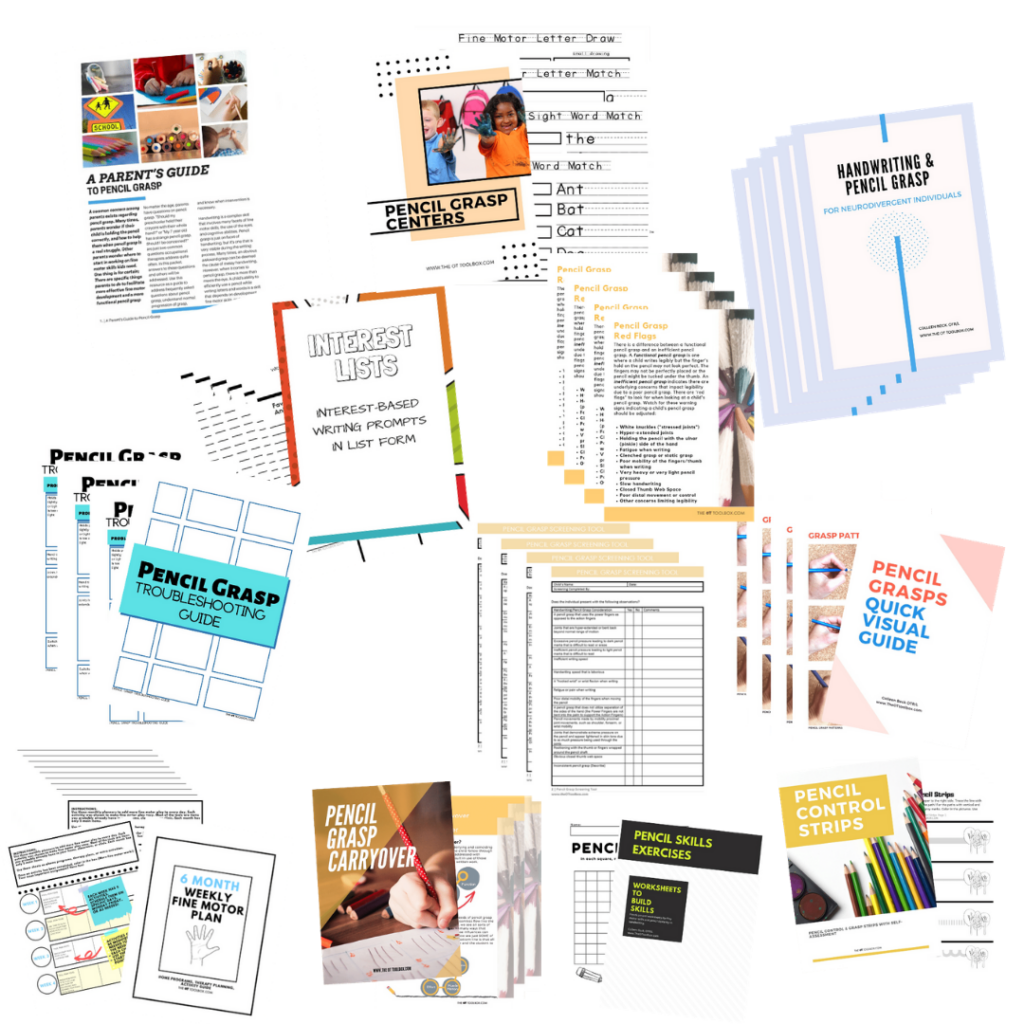
The Pencil Grasp Bundle is for those struggling to help students with carryover of skills. It’s designed to make pencil grasp practice meaningful and motivating. The Pencil Grasp Bundle is 16 pencil grasp resources, guides, worksheet sets, and tools.
Pencil Grasp Success Was Never Easier.
- It can be a real struggle to help kids address tricky pencil grasps.
It is frustrating and difficult to weed through all of the information and pull out what will work for a child. - You struggle with kids who work on skills but can’t carryover handwriting and pencil grasp into the classroom.
- Therapists may search for fresh ideas to address pencil grasp needs and wonder whether a grasp is considered functional or needs changing.
- Therapists need pencil grasp screening and educational materials to address a huge influx of therapy referrals.
- Parents wonder about development and skills.
- Teachers will love the Centers activities to incorporate into learning to impact carryover of handwriting skills.
The Pencil Grasp Bundle includes 16 products and is valued at over $73. It’s bundled together and offered at just $24.
More pencil grasp help
Want to know how to fix a problem with pencil grasps? Need help knowing where to start when it comes to immature pencil grasps or a child hating to write because their hand hurts? The Pencil Grasp Challenge in open for you! In this free, 5 day email series, you’ll gain information, resources, specific activities designed to promote a functional, efficient pencil grasp.
The pencil grasp challenge is a free, 5 day mini course and challenge. During the course of five days, I’ll be teaching everything you need to know about the skills that make up a functional pencil grasp. You’ll learn what’s going on behind the inefficient and just plain terrible pencil grasps you see everyday in the classroom, clinic, or home. Along with loads of information, you’ll gain quick, daily activities that you can do today with a kiddo you know and love. These are easy activities that use items you probably already have in your home right now.
Besides learning and gaining a handful (pun intended) of fun ideas to make quick wins in pencil grasp work, you’ll gain:
- 5 days of information related to pencil grasp, so you know how to help kids fix an immature pencil grasp.
- Specific activities designed to build a functional pencil grasp.
- Free printable handouts that you can use to share with your team or with a parent/fellow teachers.
- You’ll get access to printable challenge sheets, and a few other fun surprises.
- And, possibly the best of all, you’ll get access to a secret challengers Facebook group, where you can share wins, chat about all things pencil grasp, and join a community of other therapists, parents and teachers working on pencil grasp issues.
Click here to join the Pencil Grasp Challenge.

Colleen Beck, OTR/L has been an occupational therapist since 2000, working in school-based, hand therapy, outpatient peds, EI, and SNF. Colleen created The OT Toolbox to inspire therapists, teachers, and parents with easy and fun tools to help children thrive. Read her story about going from an OT making $3/hour (after paying for kids’ childcare) to a full-time OT resource creator for millions of readers. Want to collaborate? Send an email to contact@theottoolbox.com.


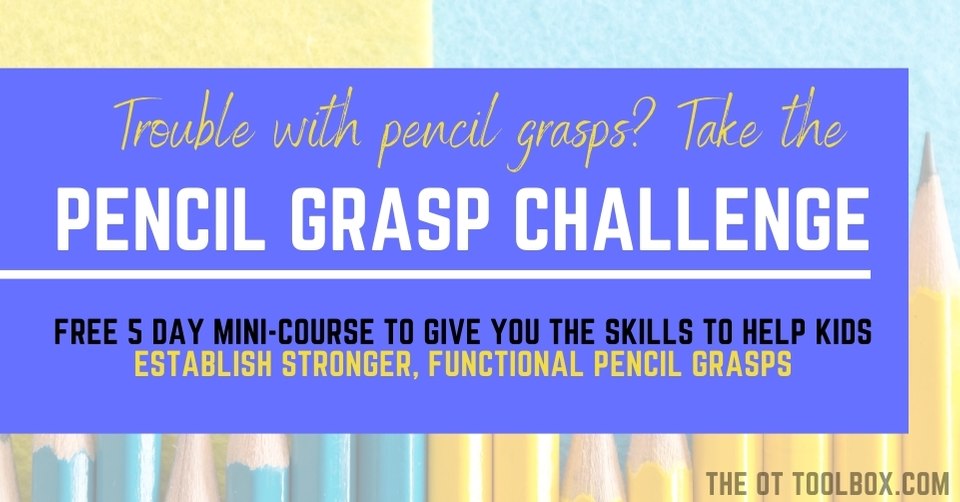





149 thoughts on “Pencil Grasp Development”
I enjoy using push pins and playing poking games. The child doesn’t have room to have anything else but a tripod grasp. i like to roll dice and that’s how many pokes you get. First one to the end of the page wins.
I enjoy using tweezers to work on pencil grasp
Hiding small beads in putty and using tongs with cotton balls are two of my go to’s!
Amazing!!
I like to use the original lite brite! You can easily up or down grade the position they do it it. It also incorporates bilateral integration and forcing them to hold the case in order to push hard enough to get the pegs into the board. Motivating to the kids and so many other benefits:)
I have the students complete various fine motor take such as removing stickers from horizontal and vertical surfaces,
pinch clothespins and remove clothespins from a ledge, file folder, or clothesline, rip paper, pick up playing cards, color Clip art with small broken crayons …!to name a few.
I will use putty, clothespins, geoboards, pegs and tongs to work on pencil grasp.
Using playdough can help build the dexterity and co-ordination useful for pencil grip.
Using small nubs of pencils are useful.
I love to use tweezers and putty!
We do a lot of playing with play doh and using teeezers from doctor kits to move things.
I use tweezers or small crayons.
I like to begin with a proprioceptive activity involving the hands and arms (animal walks, wheelbarrow walks, chair push ups, ect) then use tweezers, golf tees, and push pins for prepatory activities. Finally, using golf pencils for writing practice!
The children aboslutely love our pushpin activities. The child grasps a supersize pushpin and then pushes along a picture that has been traced on construction paper. The holes have to be close for the picture to popout. It practices grasp and control of movement along with a great deal of focus and concentration that really strengthens those finger muscles needed for a strong grasp.
theraputty play on vertical surfaces, in-hand manipulation games
Poking lite bright pegs, golf tees or pencil stubs into putty!
I like to play games like “Trouble” or “Sneaky, Snacky Squireely game” (without tongs) to help children work kn their tripod grasp and precision.
I like to set up a variety of different fine motor activities to improve dexterity in fingers and hands. Some example might be play dough to warm up fingers and hands, rolling balls and the using their index fingers to push down the play dough balls the kids love this one, I also get popsicle sticks and get them to practice putting them into the play dough and pulling them out simple but effective. My students love to push Pom poms into my container with circle cut outs, sometimes I challenge them by getting them to use tongs and tweezers.
Sensory writing activities- shaving foam, polenta, sand or salt and using a paintbrush or stick to write or draw.
If students are really struggling with pencil grasp I like to use a golf ball on a pencil to build up their pencil and make it easier for them to hold in a correct grip this one is my favourite go to.
We use playdoh, tweezers with poms, painting with Q-tips. When writing, I’ve cut two holes in a sock for his thumb and index finger to go through while he holds a marker. Or holding a cotton ball in the hand he’s writing with.
I think using tweezers during games such as bed bugs, operation, muffin match, and so many more are great for promoting tripod grasp!
First I use weight bearing activities, such as wheelbarrow walks, to build proximal stability. Then I use activities to build distal mobility and strengthen the intrinsic muscles of the hand, such as searching for small items in theraputty.
A lot of my students have difficulty with ulnar closure which impacts their pencil grasp. I like having them hold a pom-pom in the ulnar side of their hand while they write or do tweezer acitivities. I also have them pretend to be a “crab” and pinch the air with their thumb, middle, and index fingers as a quick warm up prior to writing.
We use theraputty, stickers, play dough to strengthen his fingers but haven’t had success when it comes to grasping. Still looking for the best tool for him.
Bead stringing or lacing activities are great.
In hand manipulation activities and fine motor strengthening and dexterity activities with playdough!
I like to use crayon bits to facilitate grasp and a vertical surface “coloring wall” for strengthening.
Tweezers with pom poms
Tong activities or broken crayons!
I like to do tweezer activities to help with pencil grasp..
So many good ideas already listed. But, I have my preschoolers try open zip top bags, snack storage containers and/or spice (screw top) jars to practice dexterity with a functional component. For cognition, they need to figure out which lid goes with which container. Another favorite of the kids for grasp is to paint on vertical surface using paint sticks—similar to a glue stick. Mess free and dry quickly.
In hand manipulation activities and fine motor strengthening. I also like to work with their teachers to make sure they know what they are looking for and ways in which in hand manipulation and fine motor strengthening activities can be incorporated throughout the school day.
I like to use smaller pencils, crayons, chalk which leaves limited room for anything but a tripod grasp, but I also love anything with tweezers, clothespin, playdoh/putty to strengthen the hands in order to be able to maintain the grasp once we get it down!
I love to work on pom pom games with tongs to increase hand strength as a precursor for handwriting skills. I just bingo dauber coloring pictures and put Velcro on them so the Pom poms will stick. The kids love it!
I love to use resistive toys and building manipulatives to build fine motor skills. Now doing teletherapy there are so many household items that can work on building the fondational skills to develop a proper grasp.
I also use tweezers a lot. I also have a crayon maker that makes small shapes kids have to grasp with their finger tips. One of them is a car so we use those to drive roads on paper (on the table or wall).
All the fine motor activities listed above but I always like to add in the HWT song “my thumb is bent, pointer points to the tip, tall man uses his side, I tuck the last 2 fingers in and take them for a ride…”
Tweezers are my go to. I’ve also just discovered a code cracking game with tiny pegs that have to go into holes which works on executive function and fine motor
I love to use games which require appropriate grasps. I try to have a variety of games to appeal to different interests and to increase or decrease the challenge. I enjoy playing them and the kids do too 🙂
So many good ideas! I really like push pin art on a vertical surface, tissue paper art (crumpling/rolling the paper between index and thumb), putty activities and finger games!!!
I love working on board games that promote a tripod grasp, including those that use tweezers!
I like to use tongs and have kids practice picking up small objects. I often have kids hold a small object in their last 2 fingers to reinforce a better grasp.
my favorite is to have kids do light bright pictures. I have picked up a whole bunch of them really cheaply at second hand stores. I lend them out to parents for “homework” . i encourage kids to do them while lying on the floor (so that they are getting prone extension and that they are getting excellent wrist extension too. each peg placement obligates kids to a tripod pinch and often rotation and manipulation. (if you happen to be working on crossing midline, put the pegs on their contralateral side. if working on visual figure ground, make sure they are in a container all jumbled up. it spontaneously works on form constancy with every peg.
it is a lot of fun!
I love to provide play dough pinching activities
Using activities to separate and strengthen the power and precision sides of the hands. Also, using small tools for activities and writing/coloring.
We use a lot of tweezers too….. And broken crayons and small pencils!
Using any small tools/toys that require the child to use a proper grasp pattern (broken crayons, small pieces of sponges, broken Q-tips, small beads, use of tweezers).
I love having a crayon breaking party! We break them and then peel off the paper before coloring.
Playdoh, in hand manipulation activites,stickers etc; initially the focus is on tasks that work on developing/strengthening a pincer grasp. Also do a lot of work in prone position to help strengthen the upper body and help to isolate and promote hand movement.
I like to use variety of fine motor manipulatives on the vertical surfaces or in prone positions. I target the core and the shoulder strengthening along with activities that encourage hand skills. My favorites are using painter’s tape, drawing with small crayons, bubble wrap popping, and playing board games.
Every single crayon in the OT room is broken into small pieces. I love short pencils, short pieces of chalk, etc. It’s hard (but possible) to grip a small piece of crayon in any way except the tripod grasp. I also use rolled up tissue paper in the hypothenar eminence, held by the 4th and 5th digits to help the student not use these digits.
Holding a pom pom or other small object on the ulnar side of the hand while writing or doing other tasks!
So many fun ways to work on pencil grasp without having to pick up a pencil!! I love activities using tongs or clothespins!
Being thrown into teletherapy like most therapists this spring was a challenge. This blog was a lifesaver for ideas and information! Parent coaching and creating simple sensory break ideas using home materials was my go to for teletherapy! A creative challenge!
I work on a variety of activities: using tweezers and tongs to pick up different sizes of items, finding beads in theraputty, manipulating play doh, peeling stickers, using golf pencils or flip crayons, working on vertical surfaces, weight bearing activities, etc.
I love using tweezers to get children using a tripod grasp!
I use a variety of items including, putty, Legos, Q-tips, tongs, spray bottles, etc.. I incorporate fun activities using these items. I often work on core strength at the same time using floor and vertical activities.
Putty, tongs, and q-tip paintings
I love posting coloured match sticks into the holes of old spice bottles. Push pins are also an ultimate favorite!!
Outside – Using tweezers to hunt for bugs, picking flowers, squeezing water toy/animals
Inside – use tweezers/adapted chopsticks to eat snack, Paper ripping/mosaic craft, Bunchems
Push pin activities are great to work on pencil grasp and strength. I use extra large push pins to do this!
I like to use the grotto grip and a rubber band around the hand and pencil so the pencil lays in the thenar webspace. I also like using broken triangle crayons.
I like to work on big movements using weight bearing and then move to small muscle work with tongs, tweezers, beads, putty, etc.
I like using lite brite
I like to use play-doh or putty to warm-up their fingers/hands then use push pins, tweezers/tongs or clothespin games, q-tips to paint, pegs, small pieces of chalk, crayons, or pencils to work on pencil grasp.
Hi,
I am a COTA and work in schools, most of the referrals are related to the student having a pencil grasp that is not functional. Having this tool will really weed out what work and doesn’t.
I like slicing a tennis ball and making it into a fun character. I have the child remove different items from the inside of the characters mouth. Different characters have a more wide mouth and some are more narrow to grade the activity.
I work with little ones so we do a lot of practice with pincer grip – anything we can challenge them to pick up or squeeze. One favorite is eyedroppers and liquid watercolors on color diffusing paper or coffee filters. Also anything with tweezers – I have different sizes children can use depending on their level of mastery and grip strength.
So many good ideas have been listed. I like to do hand warm up exercises and move into activities for strength and in hand manipulation. Some ideas would include: theraputty, clothespins, tweezers, lite bright, stickers, colorforms or writing on a vertical surface, crumbling paper, tearing paper, play dough, arts and crafts activities. These are just a few
I’d like to incorporate games that require use of tweezers, small play pieces, and lacing.
Working in vertical is a must! Also, using tiny crayons, tweezers/tongs, ripping paper, etc. So many good and fun ways to work on grasp!
I love using putty, beads, tweezers/tongs, pegs, games like Speedy Match, Travel Connect Four, Hi Ho Cherrio, The Sneaky Snaky Squirrel (with differnt tongs), etc
I love clothespins and clip cards.
Beads or small items in theraputty, push pins, tweezer activities, mini clips,lacing,stringing beads
I like to use putty, tweezers, tongs, putting erasers into medicine boxes etc. while making it fun. I like to use a rubber band, kind of like a handiwriter to keep the web space open and to help my son find the right position, since right now his go to is a digital pronate grasp. I also love using rock crayons – so great- especially if your child, like mine, has something against broken crayons!
I usually start with heavy work activities involving weight bearing on hands as prep, then move on to removing/burying small items in putty, clothespin and tong games, and using manipulative like small stamps, sorry game pieces or mini bowling pins to promote tripod grasp
Meet their sensory needs first. Then I try to hit all the foundational components in a obstacle course type of activity that ends with a more fine-motor task that addresses the motor skills for a pencil grasp. So it might look like this: jump on a trampoline or go through the compression roller, then propel a scooterboard while prone, use tweezer/tong activity, then add a piece to an alphabet puzzle and end at the white board to form the letter. All this happens on the floor in active movement.
I like to use tweezers, putty and small pencils crayons etc.
I use everything that does NOT involve s pencil, but works those muscles that they need in order to hold and move a pencil effectively. I have every tiny toy out there, haha. My favorites with my older crew is to use a q-tip for painting or tracing as well as a push pin to trace along designs by poking holes.
I love playing games with chopsticks with chopstick helpers, tweezers and tongs!
Tweezers, peg type activities on a vertical surface, nesting activities, pinching to find beads in putty, placing coin like items in a bank.
Perler bead designs are great for grasp and visual spatial planning and can be graded up or down for all ages.
Anything that works on those small finger muscles! Stringing beads, play doh, tongs, small legos, chalk, pegs, clothes pins, etc. I also think it is important to talk to kids about WHY we are wanting them to hold a pencil a certain way.
I like to use the rock crayons and golf pencils to help with handwriting. Another idea that I haven’t tried but love for kiddos that use too much force is putting a piece of foam under their paper. This will teach them to lighten up because if they push too hard the tip will go through the paper!
Some activities I like to use to work on pencil grasp skills are active movement and pressure based activities which can help when holding a writing instrument. For example: a fun game of tough/war with a rope that resembles the width/length of the preferred writing instrument, playing with a “magical” wand with its handle closely related to the writing instrument and holding it in a variety of ways/positions, and so on.
I like to provide students with broken crayons to color coloring pages of clothes. Then after cutting them out, they can pretend to do laundry by using clothespins to hang the paper clothes on string that’s tied between two chairs.
Lite brite, travel connect 4, tweezers, using one piece of a stackable pencil, vertical surface.
I love hiding items in theraputty, using small crayons to draw on vertical surface & tong activities
I like to use small fine motor manipulative like lite brite pieces, mini pop beads and pinch clips.
I like using beads in putty to warm up then playing racing games with tongs or water droppers!
Some activities that I like to do is: lite Brite, rubber bands to an object, tearing/crumpling/flicking paper, cutting straws and then stringing them, coins out of playdough/putty, flipping or twisting coins or objects, finger twister and so much more!
putty activities, including cutting it, tong/tweezer activities, bead activities
I use a variety of activities, from tweezer pinch and pick up, lite brite or small pegs, beading, putty seek and find to pinch and pull small hidden objects, tearing and balling up paper for “mini basketball”, rubber bands on tubes and sticks, stickers, and more. Anything that will promote a three finger or pincer grasp to help strengthen the intrinsic muscles of the hand.
I really like to use an empty spray bottle with water play in order to strengthen their hands and have them use broken crayons or “rock” crayons in order to facilitate a tripod grasp.
I tend to address hand and finger strength first. Poking small sticks or similar items into putty or play dough and then pulling them out is a fun activity to do this. As children are nearing the goal, I will put three dots on their pencil to give them a place to position their fingers.
I like to use any activities using tweezers. I even like to have our students bake cupcakes and then they have to put sprinkles on using their tweezers. If they don’t use their tweezers, they don’t get sprinkles. Thanks for your blog! I love all of the ideas people are sharing.
Lots of good ideas have been mentioned! I use tongs and tweezers to place items in containers, to sort and to build towers with small blocks. Also, pushing pegs in to clay and pulling them out and using small writing tools like chalk pieces and Flip crayons.
With teletherapy because our main source of the session, I’ve been trying to incorporate everyday items at home. My favorite so far have been using stickers, clothes pins + pom Pom, putty + beads, and hand warm up games.
All sorts of fun things to work on intrinsic hand muscles, and I really love golf pencils (the ones with erasers!), used on a vertical surface.
I usually use a small bead and place it under the pinky finger and the ring finger….. Initially by using hand over hand method those two fingers remain closed forcing the tripod grasp… Then activities like playing with play dough, poking, .. Using pegs, removing pegs, using tweezers to pick objects… It works very well
I love using clothespins to pick up pom poms and having the child use only 2-3 fingers or having roll playdoh into a ball and then push something like broken crayons or cheerios into the top of the ball to make a cupcake! It forces them to use only a few fingers while manipulating the small item and also works on grading of force as if they push too hard, they squish the cupcake!
First, I love reading all the great ideas in all the comments! Sometimes you get in a rut and these comments really jog your memory and help to shake things up a bit!
I love teaching my students to finger knit. Once they get it, they love it. I also like taping pieces of yarn to the top of my easel and letting them hang down to the bottom then they kids get a cup of beads to string without letting them fall off. Fun! If they fall off, they get more practice by getting to pick them up off the floor.
It’s wonderful how students automatically pick up a very short crayon with a tripod grasp. I like to use putty, tongs, and clothes pins for strengthening, and to incorporate finger movements like finger opposition, and in-hand manipulation to improve dexterity.
Anything pinching!!
I incorporate sorting activities by using tweezer, cloth peg or tongs, peeling small stickers to make any pattern, hiding marbles inside the theraputty, pounding cashewnut, lots of weight bearing on hands activities, lacing, beadings, rolling play dough, cookie cutter and play dough, pushing and pulling and last my favourite is rubber band activity.
Putty, Playdoh, tweezers, tongs, breaking crayons and peeling the wrappers off, lacing, beading, clothespins, anything w/ small parts that incorporate hand strengthing- legos, knex, etc.
lacing, clothespins, finding beads in putty, painting with qtips, so many things to do
I like to use small clothespins, putty, tongs and small peg board. Thanks for the chance to win.
tweezers, clothes pins, coloring on a vertical surface
Pick up sticks using tweezers among others that promote a tripod grasp.
Tongs, play doh, tape activities, you name it! So many things to strengthen the hands to improve grasp!
I like to use play doh, pompoms, tweezers, and golf tees in styrofoam to build grasp skills.
Using small crayons, q-tip painting, fine motor pincer grasp activities.
Push pin art projects, peg board activities, rubber band stretching to place on a ball with spikes or on a geo board, putty pinching and pulling, Using small writing tools when coloring and writing, Use of incline board, lay on floor when coloring or writing, pop beads just to name a few.
Pincer activities
I have an old portable lite brite that I picked up at a thrift store years ago. It fits in a tote back and is battery operated. Love it! Also tweezers finding beads in play doh. I appreciate reading all the comments with ideas. Great Post! Thanks!
Using tools like tweezers, tongs, push pins are great and can be used in a variety of games and activities. I also like using hiding items in playdough, putty or other resistant material.
cotton balls
Putty, small beads and Pom poms, Tongs, stickers
So many faves…for older students I like push pin art. For my pre-k set, I like bingo chips or coins/buttons in putty or playdough.
Activities the promote separation of the two sides of the hand
Tong, tweezer,clothespin, resistive putty activities.
I like using tweezers and a variety of manipulation games that help with in-hand development.
I like using playdoh, or threading beads onto string.
Play-doh, Lite-Bright, tweezers, board games, lacing, and coins placed into a small container are some of my favorite activities.
Tongs, playdough, theraputty, clothespins and Get Ready exercises with fingers and hands. Scooterboard, monkey bars, trapeze swing are some of my other favs.
Use kids chopsticks while eating. Also playdough. Encourage playing on bars and climbing the playground domes when outdoors.
I like to have the student hold something small with their ring and pinkie fingers while holding the pencil.
Using playdoh and tweezers.
I offer lots of opportunities to use play dough and clay, squeeze bottles, droppers, tongs, and stringing beads.
I like to work on pencil grasp indirectly with Perler Beads, TheraPutty, and even a rubber band on the back of the pencil to add weight in the correct position! But, I’d love to learn more with this bundle!
Stickers!!!! So many ways to place them to make a dot to dot using numbers or the alphabet, to cut along, to make faces with, to place on a wall, etc.
I like using play doh and tweezers to work on FM strengthening and grasp development!
I like to use clothes pins to have the child pick up small objects. I also like to use tongs to grab pom poms.
I use a variety of activities from push pins, theraputty, tweezers, beads and stickers.
Besides writing or drawing tasks themselves, I like using spray bottles, tongs, and fine motor play like connecting blocks, stringing beads for strengthening and coordination!
Coloring on an elevated surface while standing, beads and putty, tongs.
I use exercises and warm ups and then several types of letter/number practice while experimenting with different grips
I enjoy using stamps, since that can be fun and interesting with the kids and also introduces them to a gross, tripod grasp!
I use all kinds of games that require the use of tongs. Some are store bought and since made up.
I always give my students different pick up and transfer activities using various types of tongs and tweezers.
I love playing games with tweezers and rings. Hiding things in putty and making patterns with push pins
Kelly
Victoria
I like using tongs to pick up and sort pom poms or foam cubes. I also like using clothespins for pinch and release activities.
I like to use pin poke activites, broken crayons, tweezers/tongs, putty exercises.
I love using broken crayons, Lite Brite and the tiny take apart erasers.
I like using tongs to pick up and place objects, push pin or golf tee poke activities, and putting in and taking out pegs in play dough or putty as fine motor development activities for pencil grasp.
Using broken crayons, manipulating small media, push/pull/poke resistive putty material.
Spray bottles and play doh!
One of the strategies my students enjoy is using a song to practice grasp. I learned it from the TV Teacher and it’s about how a “big alligator goes chomp chomp chomp.” We use this song and sometimes a small item tucked into their 4/5 fingers to help stabilize their hand and then do activities that utilize the “chomped” fingers. So many were listed above but things like coloring with broken pieces of crayons, ripping paper to make a craft, play dough play, etc.
Comments are closed.